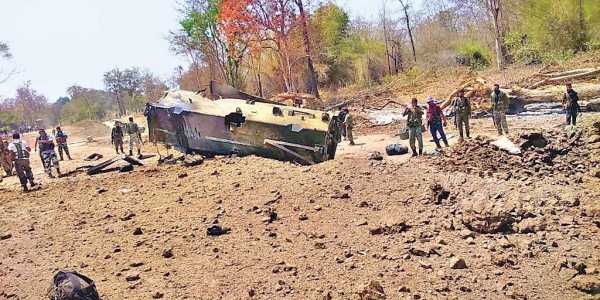
MAOIST ATTACK IN SUKMA
Context
A team of security forces was attacked by a maoist group called People’s Liberation Guerilla Army
(PLGA) unit in the Tarrem area near the Sukma-Bijapur district border, Chhattisgarh. Several security
personnel were killed and many were injured.
MORE ABOUT NEWS: LEFT WING EXTREMISM IN INDIA REASONS FOR LEFT WING EXTREMISM

Government Initiatives to Fight LWE
Greyhounds – It was raised in 1989 as an elite anti-naxal force.
Operation Green Hunt – It was started in 2009-10 and massive deployment of security forces was done in the naxal-affected areas.
LWE Mobile Tower Project – To improve mobile connectivity in the LWE areas, the Government in 2014, approved installation of mobile towers in LWE affected States.
Aspirational Districts Programme – Launched in 2018, it aims to rapidly transform the districts that have shown relatively lesser progress in key social areas.
SAMADHAN
It stands for
o S- Smart Leadership,
o A – Aggressive Strategy,
o M- Motivation and Training,
o A – Actionable Intelligence,
o D- Dashboard Based KPIs (Key Performance Indicators) and KRAs (Key Result Areas),
o H- Harnessing Technology,
o A -Action plan for each Theatre, and
o N- No access to Financing.
ISSUES IN HANDLING LWE
Negligence of established standard operating procedures at times leads to loss of valuable lives of security personnel. For example – April attack in Sukma resulted in loss of lives of at least 25 CRPF personnel
Certain vulnerabilities remain such as poor planning, inadequate numbers, insufficient intelligence backup etc.
Structural deficits and deficiencies such as putting IPS deputationists into almost every senior position in CRPF ignoring the decades of experience within the Force.
Sluggish Capacity building of police forces, for example – in Chattisgarh, there are about 10,000 vacancies in different ranks in state police and 23 sanctioned police stations have yet to be set up.
LWE is well trained in guerilla warfare.
Inefficient technology of mine detection: Nine CRPF jawans were killed recently in Chhattisgarh’s Sukma when a mine protected vehicle was blown up by triggering an Improvised Explosive Device (IED). Present technology is unable to detect deep planted mines under the road.
Delay in acquisition of technology: For example- Out of the 157 sanctioned MPVs, only 13 have been supplied by OFB to CAPFs so far.
Funds through NGOs: Expanding its investigations, the Enforcement Directorate has zeroed in on NGOs that are suspected to have funded Naxal operatives in the State.
Laundering of funds: Naxal leaders operating in Bihar and Jharkhand are laundering extorted money through acquiring movable and immovable assets.
WAY FORWARD
Learning from Chattisgarh police: As the Chhattisgarh police have experience in tackling Maoists in Bastar, they are now coordinating with the bordering States to strengthen intelligence and ground presence. Such measures can be taken in new areas as well where Maoists are trying to establish themselves.
Eliminating the root cause of the problem that is leading to the alienation of tribals in this area.
The focus should now be on building roads, installing communication towers, increasing administrative and political access of the tribals, improving reach of government schemes etc.
Centre-state cooperation – Centre and states should continue with their coordinated efforts where Centre should play a supportive role with state police forces taking the lead.
Undertaking technological solutions – such as use of micro or mini-UAVs or small drones to minimize loss of lives of security personnel.
Build trust – Winning a psychological war against the Maoists remains an unfinished task. To bridge this trust deficit, civil society must join hands with the government in realising the villagers’ right to development.
Awareness generation – Government should undertake awareness and outreach programmes and inclusive developmental programmes.
Forest Rights – Effective implementation of the Scheduled Tribes and other Traditional Forest Dwellers (Recognition of Rights) Act, 2006
Financial empowerment – Introduce measures to encourage formation of ‘Self Help Groups’ (SHGs) to improve access to credit and marketing and empower the disadvantaged.
Choke funding – The nexus between illegal mining/forest contractors and transporters and extremists which provides the financial support for the extremist movement needs to be broken through establishment of special anti-extortion and anti-money laundering cell by State Police.
Infrastructure development- For implementing large infrastructure projects, particularly road networks that are strongly opposed by the extremists or are used to extort funds from local contractors, the use of specialised Government agencies like the Border Roads Organisation in place of contractors may be considered as a temporary measure. Special efforts are needed to monitor the implementation of constitutional and statutory safeguards, development schemes and land reforms initiatives for containing discontent among sections vulnerable to the propaganda of violent left extremism.
